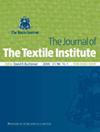针刺非织造毯的刚度和耐磨性研究
IF 1.5
4区 工程技术
Q2 MATERIALS SCIENCE, TEXTILES
引用次数: 2
摘要
针刺织物的性能取决于组成纤维的性质和纤维在结构中的排列方式。纤维的特性以及各种机器和网的参数决定了针刺过程中产生的结构。本文研究了针刺毛毯的穿针深度和冲孔密度等机器参数对织物刚度和耐磨性的影响。研究了在两层细涤纶纤维之间压延和夹装中空涤纶纤维对织物耐磨性和刚度的影响。结果表明,织物刚度随针入深度的增加先增大后减小。增加冲孔密度导致织物刚度下降,只有在较高的穿透深度,由于纤维断裂。压延提高了织物的耐磨性,但也增加了织物的刚度。将中空聚酯纤维夹在两层细旦聚酯纤维之间,在不增加织物刚度的情况下,提高了织物的耐磨性。本文章由计算机程序翻译,如有差异,请以英文原文为准。
Study of stiffness and abrasion resistance of needle‐punched nonwoven blankets
The properties of needled fabrics depend on the nature of component fibers and the manner in which fibers are arranged in the structure. Fiber properties along with the various machine and web parameters contribute to the structure that emerges from the needling operation. In this paper, the effect of machine parameters such as depth of needle penetration and punch density on fabric stiffness and abrasion resistance of needled blankets has been studied. The effect of calendering and sandwiching hollow polyester fibers between two layers of fine polyester fibers on the abrasion resistance and fabric stiffness has also been studied. It was observed that fabric stiffness first increases and then decreases as the depth of needle penetration increases. Increase in punch density leads to a decrease in fabric stiffness only at higher levels of depth of penetration due to fiber rupture. Calendering improves the fabric abrasion resistance properties but fabric stiffness also increases. Sandwiching of hollow polyester fibers between the two layers of fine denier polyester fibers improves the abrasion resistance without increasing the fabric stiffness.
求助全文
通过发布文献求助,成功后即可免费获取论文全文。
去求助
来源期刊

Journal of the Textile Institute
工程技术-材料科学:纺织
CiteScore
4.20
自引率
5.90%
发文量
149
审稿时长
1.0 months
期刊介绍:
The Journal of The Textile Institute welcomes papers concerning research and innovation, reflecting the professional interests of the Textile Institute in science, engineering, economics, management and design related to the textile industry and the use of fibres in consumer and engineering applications. Papers may encompass anything in the range of textile activities, from fibre production through textile processes and machines, to the design, marketing and use of products. Papers may also report fundamental theoretical or experimental investigations, including materials science topics in nanotechnology and smart materials, practical or commercial industrial studies and may relate to technical, economic, aesthetic, social or historical aspects of textiles and the textile industry.
All published research articles in The Journal of The Textile Institute have undergone rigorous peer review, based on initial editor screening and anonymized refereeing by two expert referees.
 求助内容:
求助内容: 应助结果提醒方式:
应助结果提醒方式:


